Related Research Articles

Southwark is a district of Central London situated on the south bank of the River Thames, forming the north-western part of the wider modern London Borough of Southwark. The district, which is the oldest part of South London, developed due to its position at the southern end of the early versions of London Bridge, for centuries the only dry crossing on the river. Around 43 AD, engineers of the Roman Empire found the geographic features of the south bank suitable for the placement and construction of the first bridge.

Bermondsey is a district in southeast London, part of the London Borough of Southwark, England, 2.5 miles (4.0 km) southeast of Charing Cross. To the west of Bermondsey lies Southwark, to the east Rotherhithe and Deptford, to the south Walworth and Peckham, and to the north is Wapping across the River Thames. It lies within the historic county boundaries of Surrey. During the Industrial Revolution Bermondsey became a centre for manufacturing, particularly in relation to tanning. More recently it has experienced regeneration including warehouse conversions to flats and the provision of new transport links.
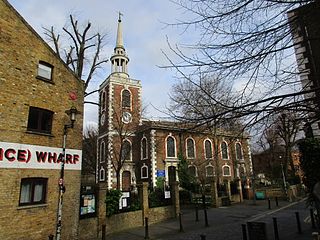
Rotherhithe is a district of south-east London, England, and part of the London Borough of Southwark. It is on a peninsula on the south bank of the Thames, facing Wapping, Shadwell and Limehouse on the north bank, with the Isle of Dogs to the east. It borders Bermondsey to the west and Deptford to the south-east. The district is a part of the Docklands area.
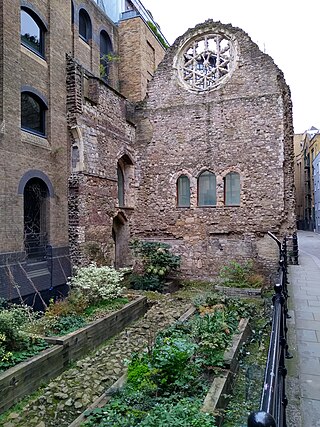
Winchester Palace was a 12th-century bishop's palace that served as the London townhouse of the Bishops of Winchester. It was located in the parish of Southwark in Surrey, on the south bank of the River Thames on what is now Clink Street in the London Borough of Southwark, near St Saviour's Church. Grade II listed remains of the demolished palace survive on the site today, designated a Scheduled Ancient Monument, under the care of English Heritage.
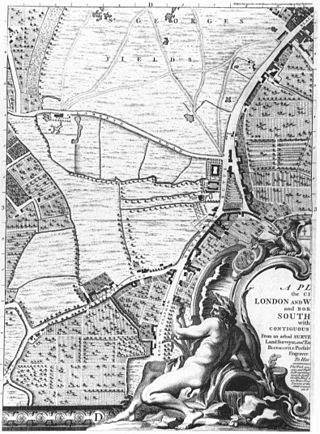
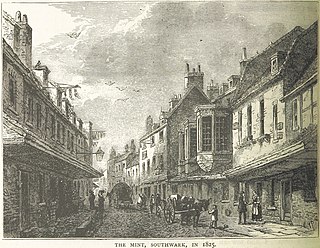
The Mint was a district in Southwark, south London, England, on the west side of Borough High Street, around where Marshalsea Road is now located. It was so named because a mint authorised by King Henry VIII was set up in Suffolk Place, a mansion house, in about 1543. The mint ceased to operate in the reign of Mary I and Suffolk Place was demolished in 1557. In the late-17th and early-18th centuries, the area was known for offering protection against prosecution for debtors due to its legal status as a "liberty", or a jurisdictional interzone.
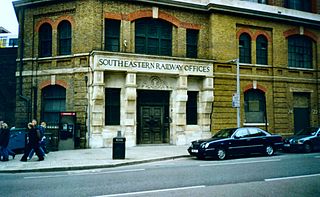
Tooley Street is a road in central and south London connecting London Bridge to St Saviour's Dock; it runs past Tower Bridge on the Southwark/Bermondsey side of the River Thames, and forms part of the A200 road.

Bermondsey Abbey was an English Benedictine monastery. Most widely known as being founded in the 11th century, it had a precursor mentioned in the early eighth century, and was centred on what is now Bermondsey Square, the site of Bermondsey Market, Bermondsey, in the London Borough of Southwark, southeast London, England.
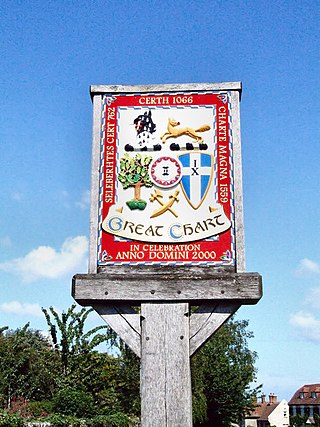
Great Chart is a village and former civil parish, now in the parish of Great Chart with Singleton, in the Ashford borough of Kent, England. The parish is split between the ancient village of Great Chart and the modern Singleton neighbourhood on the western outskirts of Ashford. The village centre of Great Chart is 2 miles (3.2 km) from the town centre. In 1961 the parish had a population of 969.

The Liberty of the Clink was an area in Southwark, on the south bank of the River Thames, opposite the City of London. Although situated in Surrey the liberty was exempt from the jurisdiction of the county's sheriff and was under the jurisdiction of the Bishop of Winchester who was usually either the Chancellor or Treasurer of the King.

West Dulwich is a neighbourhood in South London on the southern boundary of Brockwell Park, which straddles the London Borough of Lambeth and the London Borough of Southwark. Croxted Road and South Croxted Road mark the boundary between Southwark to the east and Lambeth to the west. The suburb of West Dulwich dates back to the 17th century when the often flooded land known as Dulwich Common was acquired and drained by Edward Alleyn's estate.
The Borough Compter was a small compter or prison initially located in Southwark High Street but moved to nearby Tooley Street in 1717, where it stood until demolished until 1855. It took its name from 'The Borough', a historic name for the Southwark area of London on the south side of the River Thames from the City of London. This replaced a lock-up as part of the city's court house under the jurisdiction of the Lord Mayor and Court of Aldermen of the city, and their High-Bailiff of Southwark. This first court house was converted from the old church of the parish St Margaret. A floor was made across the level of the church's gallery and the windows below that were blocked in, the Court Room being on the first floor. This structure was destroyed in the Great Fire of Southwark in 1676.
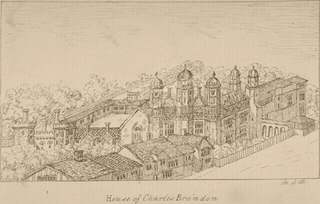
Suffolk Place was a mansion house located on the west side of Borough High Street in Southwark, Surrey, on the south bank of the River Thames opposite the City of London. It was the London town house of the Dukes of Suffolk, and was located near Winchester Palace, London seat of the Bishop of Winchester. The position was highly prominent as Borough High Street was the principal thoroughfare leading from London Bridge and the City of London, to Canterbury and Dover, a route used by monarchs and others, including the pilgrims in Chaucer's Canterbury Tales. It was built in the fifteenth century and rebuilt in fine Renaissance style in 1522 by Charles Brandon, 1st Duke of Suffolk (c.1484-1545) a favourite of King Henry VIII. On 4 February 1536 it was taken over by King Henry VIII who exchanged it with Brandon for Norwich Place on the Strand, on the north side of the Thames, nearer to the Palace of Westminster.

St Olave's Church, Southwark was a church in Southwark, England which is believed to be mentioned in the Domesday Book of 1086. It was located on Tooley Street which is named after the church, i.e. 't'olous'. It became redundant in 1926 and was demolished. It is now the location of St Olaf House, which houses part of the London Bridge Hospital.

Long Lane is a main east–west road in Southwark, south London, England.

Bermondsey Square is on Tower Bridge Road in Bermondsey, south London, England. It was the site of the 11th-century Bermondsey Abbey. The earliest medieval remains found are a Norman church from around 1080, which was recorded in the Domesday Book of 1086. The Abbey grounds were the original site of Bermondsey Market, which still takes place weekly in the Square. The area has subsequently undergone redevelopment and Bermondsey Square now contains apartments, offices, a boutique hotel, restaurants, an independent cinema, and a contemporary art gallery.
Bridge Without was a historical ward of the City of London situated to the south of the River Thames, which existed between 1550 and 1899. The area of the Bridge Without ward today forms part of the London Borough of Southwark. It was so-called to distinguish it from the ward of Bridge Within which covered the buildings on London Bridge and the nearby north bank of the Thames. Bridge Within since 1978 is formally called Bridge and Bridge Without.
Guildable Manor is a Court Leet in Southwark under the authority of the City of London, along with the King's Manor, Southwark, and the Great Liberty. The name of 'Guildable' first recorded in 1377 refers to the collection of taxes there and was adopted to distinguish this from the other manors of the Southwark area. Its legal title, according to a Royal charter granted to the City by King Edward III in 1327, is 'the ville of Southwark' i.e. 'ville = 'town'; in the more substantive charter of Edward VI it is designated 'The Town and Borough of Southwark' as is stated on its Seal. It is a preserved limited jurisdiction under the Administration of Justice Act 1977. Although neither a guild nor a livery company, the Guildable Manor does have a permanent organization, consisting of Officers and Jurors.
This is a list of the etymology of street names in the London district of Southwark. The area has no formally defined boundaries – those utilised here are: the river Thames to the north, Tower Bridge Road to the east, Bricklayers Arms/New Kent Road/Elephant and Castle to the south, and London Road/St George's Circus/Blackfriars Road to the west.
St Margaret was a parish in the ancient borough of Southwark, located south of the River Thames in the Brixton Hundred of Surrey. It was abolished in 1541 during the Dissolution of the Monasteries and replaced with the parish of St Saviour. The parish church was located on what is now Borough High Street and the area now forms part of the London Borough of Southwark. It was from 1444 governed by the Guild of the Assumption of St Margaret's Church.
References
- ↑ Southwark and the City pp10-25, David Johnson OUP 1968
- ↑ Medieval Southwark pp 18-22 Martha Carlin, Hambledon Press 1999
- ↑ Map of the City of London Manors and other Manor boundaries in Southwark , The Guidable Manor
- ↑ Reproduced and translated as Appendix in Johnson ibid
- ↑ Text reproduced with Referenced Commentary in Guildable Manor Annual Court Leet Report: 2005 by Tony Sharp
- ↑ Summons to Southwark Courts Leet issued from Central Criminal Court at Old Bailey
- ↑ sa 'Southwark' in Domesday
- ↑ Carlin ibid
- ↑ 'Plan of Southwark ca 1543; Duchy of Lancaster
- ↑ Annales Bermundsei
- ↑ Survey of London "Bermondsey" John Stow 1590
- ↑ Domesday ibid
- ↑ Annales Bermundsei